Chapter 7 Water Pollution Synopsis
- 197 percent of the water on Earth is saline sea water, 2 percent is trapped in ice caps and only 1 percent remains in the rivers, lakes, underground aquifers, and other fresh waterbodies.
- Water pollution occurs when any chemical or organic substances, toxic substances or germs are mixed in the water due to different indiscriminate human activities and various natural causes and the water becomes unfit for humans and other animals to use.
- When the used, warm and contaminated wastewater from thermal power stations, nuclear power plants, and factories mix directly in the ponds or rivers reducing the oxygen level of those waterbodies, thermal pollution occurs.
- As a result of the uncontrolled extraction of excess groundwater, arsenic compounds react with air to form toxic metallic compounds. These compounds contaminating water, are called arsenic contaminators.
- Radioactive substances used in nuclear reactors, medical centers or scientific laboratories are dumped into the sea or river after use. This causes radioactive pollution.
- Wastewater from agricultural fields rich in nitrates, phosphates, and sulphates are carried to nearby ponds, lakes, rivers, etc.
- As a result, the nutrient level of the water bodies increases, which promotes the excessive growth of algae, weeds, and water hyacinths, and subsequently aquatic animals die due to reduced levels of dissolved oxygen. This phenomenon is called eutrophication.
- In 1932, liquid waste containing methylmercury from a chemical factory off the coast of Minamata Bay in Japan was discharged into the sea. This methyl mercury got deposited in the body of marine fishes.
- Later, the inhabitants of the coast became infected with incurable diseases (deaths and disabilities) as a result of eating these fishes. This mercury poisoning is known as Minamata disease.
- When high doses of arsenic enter the human body through drinking water and food, it causes black sores on the palms of hands and soles of feet. It is known as Blackfoot disease.
- When high doses of cadmium enter the human body through drinking water and food, the bones of the human body become brittle and cause intolerable pain. It is called Itai-Itai disease.
- Fluoride contamination causes problems in human teeth and bones. It is known as fluorosis disease. It is a disease caused by calcium deficiency.
- Waterborne infection can be prevented by drinking pure water, maintaining general rules of cleanliness, using lavatories, and disposing of garbage at the proper place.
- Water can be purified in various ways, such as boiling water for 10 minutes at 100°C temperature, covering the turbid water for some hours so that most of the filthy things can be deposited at the bottom, mixing adequate amounts of chlorine with water, etc.
- A severe shortage of water all over the world can be compensated by the prevention of water pollution as well as minimizing excessive use of water and reusing it to the maximum capacity.
WBBSE Solutions For Class 7 Geography
Chapter 7 Water PollutionAnalytical Type Questions
Question 1. Discuss the causes of water pollution.
Answer:
Causes of water pollution:
Water can be polluted in various ways-
1. Pollution due to industrial wastes:
Water pollution is caused by industrial wastes disposed from petrochemical, plastic, fuel industries, and oil refineries (like copper, lead, chromium, calcium, zinc, and other metals, organic and inorganic compounds. of sulfur, phosphorus, and chlorine).
2. Pollution due to domestic wastes:
Vegetable peels, leftover food, detergent, soap, human wastes, and insecticides enter the rivers and other sources of water through the house drains. Again organic and inorganic wastes from markets, clinics, and hospitals also pollute water.
3. Pollution from agriculture:
The chemical fertilizers and pesticides used in agriculture and chemical substances like nitrate, phosphate, and potash produced by weeds pollute water.
The nitrates present in fertilizers hamper blood circulation in children’s brains and are also a known cause of cancer.
4. Pollution from mineral oil:
Tanker accidents in the sea, bursting of conducting pipes, and wastes produced by the combustion of engine oil in ships, steamers, and mechanized boats pollute the river and seawater.
5. Thermal pollution in water:
A lot of water is required for cooling the machine parts in atomic power plants, thermal power plants, and different industries. When this heated water falls in rivers or seas and on the ground it causes harmful ecological changes in water and endangers the existence of aquatic creatures.
Apart from this, water also gets polluted due to arsenic pollution and air pollution.
Question 2. Write down the causes of pollution in the Ganga.
Answer:
The causes of pollution in the Ganga:
Polluted water from different sources mixes with the water of the river Ganga. The causes of pollution in river Ganga are-
1. Discharge of urban solid and liquid waste:
Often solid and liquid waste materials are discharged in Ganga from the cities located near the bank of river Ganga. These huge amounts of waste substances disposed from the cities located on the banks of river Ganga pollute the water.
2. Disposal of industrial waste:
The unrefined waste substances produced by the numerous industries which are situated on both sides of the banks of river Ganga are disposed in the river water making it unsuitable for drinking and for the survival of marine animals.
3. Washed away the water of fertilizers and pesticides:
Chemical fertilizers and pesticides used in the agricultural lands on the bank of river Ganga are washed away by rainwater to the river making the water polluted.
4. Pollution caused by shipping:
The large vessels, ships, and steamers that are used as modes of transport in river Ganga, sometimes throw burnt oil, grease, etc. into the water of Ganga which mixes with it and makes the river water polluted.
5. Other causes:
Idols, flowers used in pujas, household wastes, etc. are disposed of in Ganga. This is gradually increasing the pollution in river Ganga.
Question 3. Discuss the effects of water pollution.
Answer:
Effects of water pollution:
The effects of water pollution are as follows-
1. Effect on human health:
- Arsenic pollution can cause cancer of the lungs, liver, kidney, bladder, and skin.
- Black patches develop on the palms and soles as a result of arsenic reactions. This is called Blackfoot disease.
- Diseases like viral hepatitis, polio, cholera, and dysentery are caused by water pollution.
- IQ of children decreases due to lead pollution.
2. Effect on agriculture:
If contaminated water is used on agricultural lands, then the beneficial bacteria, virus, and other micro-organisms are killed and this affects the crops adversely. Again the presence of various heavy metals can also be detected in the produced crops.
3. Effect on the sea:
If the seawater gets polluted then it greatly harms the aquatic plants and animals as well as the entire ecosystem. For instance, the ecosystem around the Minamata Gulf was greatly harmed by mercury pollution.
Some compounds also destroy the taste and color of fish.
4. Effect on birds:
If polluted water seeps into the sea then it becomes quite harmful for fish and the birds dependent on those fish. For instance, more than a million birds were killed during the Gulf War.
Question 4. What are the essential measures of controlling water pollution?
Answer:
Essential measures of controlling water pollution:
The following measures are to be adopted to control and prevent the harmful effect of water pollution-
- Industrial effluents should be properly treated and neutralized in a scientific way before being discharged in the river.
- Domestic waste and sewage should be discharged into waterbodies only after treatment.
- Oil tankers should take careful measures to avoid oil spills.
- Waterbodies should be cleared of water hyacinths, algae, mosses, etc. Weeds and other unwanted plants must be removed from the banks before every rainy season.
- The waterbodies used for drinking purposes should not be used for washing clothes, bathing of humans and animals, etc.
- The use of chemical fertilizers and pesticides in agricultural fields should be reduced.
- Awareness regarding the harmful effects of polluted water should be spread among the common people.
Question 5. What can be done to conserve water and control water pollution?
Answer:
Ways to conserve water and control water pollution:
Water is very essential for living organisms. So to conserve water and control water pollution, the society needs to play a significant role. There are many ways to conserve water and control water pollution-
1. Avoiding misuse of water:
If not required the water tap should be closed. In this way pure water will not be wasted and water pollution will also decrease.
2. Use of harmless soap and shampoo:
Less alkaline soap, shampoo, detergent, etc. should be used which will not harm the environment and control the pollution of water.
3. Disposal of waste in a particular place:
House waste, liquid waste, etc. should be disposed off in such a place so that it would not mix with pure water.
4. Planting trees:
Vegetable plants and plants bearing fruits and flowers should be planted in gardens, banks of ponds, around wells, and tube wells. In this way polluted water can be treated and soil erosion can be prevented.
5. Reusing water:
Water should be recycled and reused in many ways.
6. Increasing social awareness:
People can be made aware of water conservation and control of water pollution through seminars, posters, essay-writing competitions, etc.
Apart from this, in low cost, knowledge can be imparted to people about water purification and different ways of water conservation.
Chapter 7 Water Pollution Short Analytical Type Questions
Question 1. What are the major water reserves on Earth?
Answer:
The major water reserves on Earth:
Three-fourths of the Earth’s surface is covered with water. Out of the total water on the Earth’s surface, 97% is ocean water of the seven oceans on Earth. The Pacific Ocean is the largest and has the maximum volume of water.
Of the three parts of freshwater, two parts are stored as glaciers and ice caps; the remaining one part of freshwater includes the water in rivers, ponds, lakes, and groundwater.
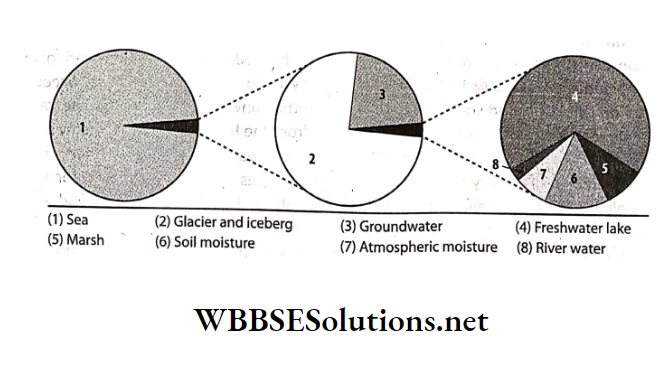
Question 2. What are the sources or causes of water pollution in villages?
Answer:
The causes of water pollution in villages are-
- In the villages, humans and animals like cattle together bathe in ponds and other smaller waterbodies. Again, in that same water, utensils, and clothes are also washed. This makes the water very polluted.
- Many villagers excrete water very polluted. on the banks of the water bodies thus leading to more water pollution.
- Nowadays, chemical fertilizers, insecticides, and pesticides are used extensively to raise crops and improve soil productivity of farmlands in villages. These are washed away by rainwater to the waterbodies, thus causing water pollution.
Question 3. What are the sources or causes of water pollution in urban areas?
Answer:
The causes of water pollution in urban areas are-
- There are many industries in the urban areas. Industrial activities create a wide variety of waste products which are discharged into the waterbodies, causing contamination of water.
- In urban areas, soaps and detergents are very widely used. These substances get discharged in the river bodies through the sewage system and cause water pollution.
- Household waste, domestic wastewater, municipal waste or sewage are also carried to the river through drains and this, pollutes the rivers.
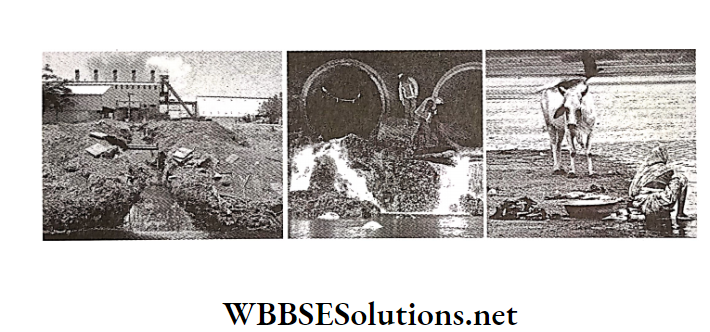
Question 4. How do heavy metals pollute water?
Answer:
Heavy metals pollute water:
Runoff from mines with high concentrations of chemicals, by-products from smelting plants, and lead emissions from vehicles cause water pollution.
These poisonous metals enter the food chain and thus are found in increasing proportion in human beings. An increased proportion of these poisonous metals in organisms can even cause death.
Some of the heavy metals causing a threat to human health are lead, mercury, cadmium, zinc, tin, manganese, cobalt, arsenic, and so on.
Question5. How does domestic waste cause water pollution?
Answer:
Domestic wastewater contains paper, polybags, plastic articles, cloth, soap, excreta, vegetable waste, etc. Polluted water from restaurants mixes with the water of ponds, water- bodies, rivers, and so on, causing water pollution.
This may cause water pollution in three ways-
- Eutrophication,
- Biological oxygen demand and
- Inorganic non-biodegradable waste.
Question 6. How do pesticides cause water pollution?
Answer:
Excessive use of pesticides, insecticides, and weedicides is common in farms practicing mixed farming, high-yielding paddy cultivation, and farming using modern techniques.
The run-off from these chemically-treated fields flows into nearby waterbodies thereby causing water pollution. This type of water pollution is called water pollution due to the use of pesticides.
The main pesticides used are D.D.T. gamaxene, endrin, folidol, etc.
Question 7. How do radioactive wastes cause water pollution?
Answer:
Radioactive elements like uranium, thorium, radium, etc. spontaneously disintegrate in a short period of time, thus emitting electromagnetic radiations like alpha and beta particles and gamma rays, which are very harmful to living organisms.
This is called radioactive pollution. Radioactive elements are used in various nuclear reactors and scientific research. The radioactive wastes are dumped into rivers, seas, and oceans after use which causes water pollution.
Question 8. What do you mean by thermal pollution of water?
Answer:
There are two main sources of thermal pollution.
They are-
- Machineries of different industries are immersed in water to cool which in turn makes the water warm.
- Warm water comes out from thermal power plants and atomic power stations.
This warm water is discharged into rivers and other waterbodies causing thermal pollution of water. Various aquatic organisms like fish die and aquatic flora is destroyed.
Question 9. What is arsenic pollution?
Answer:
Arsenic pollution:
Unlimited extraction of groundwater from wells and tubewells results in void space within the layers. Air enters these void spaces and reacts with the arsenic element of the bedrock forming poisonous arsenic compounds.
This dissolves in the groundwater causing a kind of water pollution called arsenic pollution. A high level of arsenic contamination has been found in the districts of West Bengal located to the east of River Ganga.
According to the Bureau of Indian Standards, the permissible level of arsenic in drinking water is 0.01 mg/l.
Question 10. What causes arsenic pollution?
Answer:
The causes of arsenic pollution are-
- Overuse of groundwater.
- Excessive use of insecticide, pesticide, fungicide, etc.
- Use of chemical fertilizers rich in ammonia, sulfates, and phosphates in high amounts.
- Excessive use of fossil fuels.
- Arsenic pollution may also occur while mining minerals like gold, copper, lead, etc., and in paints, soap, batteries, and medicine manufacturing industries.
Question 11. Explain fluoride pollution.
Answer:
Fluoride pollution:
Fluoride pollution is the pollution which is characterized by high levels of fluoride in water fluoride in each liter of water is considered as or air. Water containing more than 1mg of polluted water.
Excessive intake of fluoride by humans for a long time causes a medical condition called fluorosis. It damages bones and teeth, causes skin irritation, affects the eyes, and lungs, and sometimes can damage the heart in humans.
Excessive fluoride in the body can cause calcium deficiency in the body.
Question 12. What are the harmful effects of water pollution?
Answer:
Human beings as well as aquatic flora and fauna and soil are affected by water pollution in various ways such as-
- Most of waterborne diseases like Typhoid, Cholera, Jaundice (Hepatitis), Amoebiasis, and Dysentery may spread through contaminated water.
- Water contaminated with copper, mercury, sulfur extracts may cause various skin diseases in humans.
- Water pollution removes various beneficial bacteria and other micro-organisms from the soil, thus lowering the fertility of the soil.
- Toxic sea water depletes the population of both aquatic plants and animals, thus decreasing the population of fish as well.
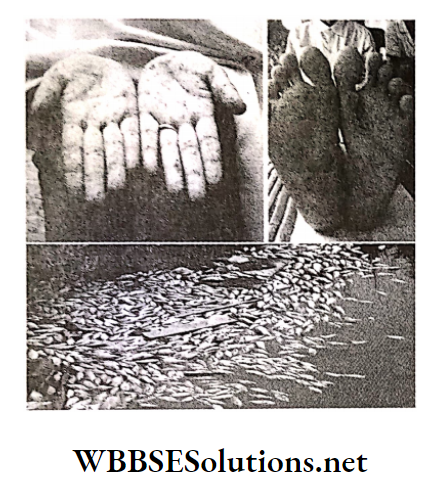
Question 13. What are the effects of water pollution caused due to use of pesticides?
Answer:
The effects of water pollution caused due to use of pesticides:
Water pollution due to the use of pesticides has the following harmful effects on humans
- Though harmful pests are killed by the use of pesticides, the indiscriminate use of pesticides leads to the growth of various other viruses and bacteria.
- pH balance of water changes. Drinking water with a pH balance of less than 4 may be fatal.
- Strong pesticides kill the aquatic flora and fauna thus disturbing the balance of the aquatic ecosystem.
Question 14. What is Minamata disease?
Answer:
Minamata disease:
Japan’s Chisso Corporation’s chemical factory released methylmercury in the industrial wastewater from 1932 to 1968 which flowed into the Minamata Bay.
This highly toxic chemical bio-accumulated in the shellfish and fish, which when eaten by the local population caused mercury poisoning. This came to be known as the Minamata disease. The symptoms of this disease are-
- Numbness of hands and legs
- Muscle weakness
- Insanity
- Paralysis.
About 2,265- people were affected by this disease and among them, about 1,784 people died.
Question 15. What happened due to oil spills in the Persian Gulf during the Gulf War of 1991?
Answer:
During the Gulf War of 1991, many oil wells of Iran and Kuwait were set on fire. Besides, a huge quantity of petroleum got mixed in the waters of the Persian Gulf. As a consequence, the ocean water was polluted and many marine organisms died.
Question 16. What are the different diseases caused due to heavy metal contamination of drinking water?
Answer:
The different diseases caused due to heavy metal contamination of drinking water are-
- ‘Blackfoot’ disease as a result of arsenic pollution.
- ‘Fluorosis’ disease as a result of fluoride pollution.
- ‘Itai-itai’ disease as a result of cadmium pollution.
- ‘Minamata’ disease as a result of mercury pollution.
Question 17. What are the effects of arsenic pollution?
Answer:
Prolonged drinking of arsenic-contaminated water has the following effects-
- The skin becomes dull/pale.
- Black spots or patches are seen on the soles of the feet, palms of hands, lower abdomen, neck, shoulders, chest, and back. This is called Blackfoot disease.
- Difficulty in standing, walking, and carrying heavy things.
- Severe pain in the limbs i.e., hands and feet.
- Cancers of the bladder, kidney, and lung. Direct consumption of arsenic leads to nausea, vomiting, blood diarrhea, metallic taste in the mouth, extreme pain in the lower abdomen, and may also cause death.
Question 18. What is eutrophication?
Answer:
Eutrophication:
Surface run-off from agricultural fields contain inorganic compounds rich in nitrates, phosphates, and sulfates, which are carried to nearby ponds, lakes, rivers, etc.
As a result, the nutrient content of the water bodies increase, which promotes the excessive growth of phytoplanktons and algae. This phenomenon is called eutrophication. If this leads to the following-
- As the number of aquatic plants increases, the Biological Oxygen Demand and the demand of oxygen of the aquatic plants increase.
- The aquatic plants and animals ultimately die due to lack of oxygen.
Question 19. What are the effects of ocean pollution?
Answer:
The effects of ocean pollution are-
- Due to oil spills in the bays and gulfs, many marine animals die,
- Direct discharge from urban sewage and industrial waste in the form of toxic wastes causes marine pollution. For instance, after the construction of Haldia Petrochemicals in Haldia, the number of hilsa fish at the mouth of the Haldi River has greatly decreased.
- Surface run-off (containing pesticides, insecticides, fertilizers, etc.) from agricultural fields causes marine pollution. For instance, a large number of fish have died in the Vembanad lagoon of Kerala, Chilka Lake of Odisha, and Kolleru Lake of Andhra Pradesh due to runoff.
Question 20. How does eutrophication affect the aquatic ecosystem?
Answer:
The harmful effects of eutrophication on the aquatic ecosystem are because of their rapid population growth, the aquatic plants require more and more quantity of oxygen and cause depletion of dissolved oxygen, thereby threatening the survival of other forms of aquatic life.
Question 21. What are the different types of water-borne diseases?
Answer:
The different waterborne diseases caused by microbes are listed below-

Question 22. Write a short note on Cholera.
Answer:
Cholera:
Type: Cholera is a waterborne disease caused by bacteria.
Micro-organism: The bacteria causing cholera is called Vibrio cholera
Symptoms:
- Watery diarrhea and frequent vomiting.
- Dehydration, dry mouth, and persistent thirst.
- Hands and legs become weak.
Question 23. Write briefly about Amoebiasis.
Answer:
Amoebiasis:
Type: Amoebiasis is a waterborne disease caused by protozoa.
Micro-organism: The micro-organism causing Amoebiasis is Entamoeba histolytica.
Symptoms:
- In the first stage of amoebiasis indigestion, acidity, and stomach infection is noticed.
- Mucus with stool.
- Abdominal pain and blood in the stool.
Question 24. What is dysentery?
Answer:
Dysentery:
Type: Dysentery is a waterborne disease caused by bacteria.
Micro-organism: The bacteria causing dysentery is known as Shigella dysentery.
Symptoms:
- Abdominal pain, vomiting, stomach infection, etc.
- Fever.
- Severe watery diarrhea accompanied by blood and mucus in stool.
Question 25. Describe Hepatitis.
Answer:
Type: Hepatitis is a type of waterborne disease caused by a virus.
Micro-organism: This waterborne disease is caused by the Hepatitis virus.
Symptoms:
- Nausea and poor appetite.
- Abdominal pain at times.
- Deep yellow urine.
- The patient gradually becomes weak.
Question 26. Write a short note on typhoid.
Answer:
Type: Typhoid is a type of waterborne disease caused by bacteria.
Micro-organism: The name of the bacteria causing typhoid is Salmonella typhi.
Symptoms:
The symptoms of this disease are –
- Stomach infections, vomiting, and abdominal pain are common.
- High temperature ranging between 104°F to 105°F persists for a long time.
- Headache and general weakness is observed.
Question 27. What measures can be taken to control waterborne diseases?
Answer:
The following measures should be taken to control waterborne diseases-
- Clean, pure, and safe drinking water is to be used.
- Water from rivers, ponds, and wells should be used for drinking only after purification.
- Hands and face should be cleaned with soap every time before eating.
- Consumption of cut fruits, ice, juice, coloured water in small packets sold on the roadside should be stopped.
- Vaccines and immunizations for the different waterborne diseases will help control the spread of such diseases.
Question 28 What are the different processes of purifying drinking water?
Answer:
The various processes for purifying drinking water are-
- Boil water at 100°C for about 10 minutes before drinking.
- Adding an appropriate quantity of chlorine to kill micro-organisms in water.
- Water is passed through charcoal, fine sand, and pebbles successively to get it purified.
- If a thin plastic bottle filled with water is kept in the sun for 6-7 hours, then the same benefits of boiled water can be obtained.
- Growing of water hyacinths helps to control the contamination of water as it absorbs many heavy metals and carcinogenic compounds present in water.
- Adding small amounts of bleaching powder in water helps to kill the microbes in water.
- Adding potassium permanganate in water also helps to kill harmful microbes in water.
Question 29. In what ways can the water that is unsuitable for drinking be changed into drinking water?
Answer:
The different ways by which water unsuitable for drinking can be changed into drinking water are-
- By removing the color, smell, and taste of the water, if any.
- By lowering the excess alkalinity of water.
- By removing the dissolved iron and manganese salts.
- By controlling the level of fluoride in water.
- By desalinating the water, if required.
- By mixing chlorine in the water.
Question 30. What measures can you take to prevent water pollution?
Answer:
Essential measures of controlling water pollution:
The following measures are to be adopted to control and prevent the harmful effect of water pollution-
- Industrial effluents should be properly treated and neutralized in a scientific way before being discharged in the river.
- Domestic waste and sewage should be discharged into waterbodies only after treatment.
- Oil tankers should take careful measures to avoid oil spills.
- Waterbodies should be cleared of water hyacinths, algae, mosses, etc. Weeds and other unwanted plants must be removed from the banks before every rainy season.
- The waterbodies used for drinking purposes should not be used for washing clothes, bathing of humans and animals, etc.
- The use of chemical fertilizers and pesticides in agricultural fields should be reduced.
- Awareness regarding the harmful effects of polluted water should be spread among the common people.
Question 31. What measures should be adopted to control arsenic pollution?
Answer:
The measures to control arsenic pollution are-
- The use of arsenic-rich pesticides and weedicides should be lessened.
- Overuse of groundwater should be stopped.
- Use of alum and bleaching powder to be practiced to control arsenic pollution.
- Tubewells should be dug up to the correct depth and the level of arsenic in the water should be checked at regular intervals.
- Consumption of boiled water should be practiced as it reduces the amount of arsenic in water.
Question 32. What measures should be taken to control plastic pollution?
Answer:
To protect our environment from the harmful effects of plastics a number of measures should be taken.
They are
- The law should be enforced to stop the manufacturing of plastic bags.
- People should be made aware about the harmful effects of plastic.
- The use of paper or jute bags should be increased instead of plastic bags.
- Plastic bags or materials should not be thrown on roads or in waterbodies.
Question 33. How can fluoride pollution be controlled?
Answer:
Fluoride pollution can be controlled in the following manner-
- Tubewell water that contains more fluoride than the permissible level should not be used for drinking.
- The source of fluoride should be ascertained and general awareness about fluoride pollution should be spread among the people.
Question 34. Which areas of West Bengal are affected by arsenic pollution?
Answer:
The districts of the Ganga Delta region of West Bengal i.e., North 24 Parganas, South 24 Parganas, Nadia, Hugli, Howrah, Maldah, and Burdwan have reported cases of arsenic contamination in groundwater.
The reported values are much higher than that of the standard values prescribed by the World Health Organisation (WHO).
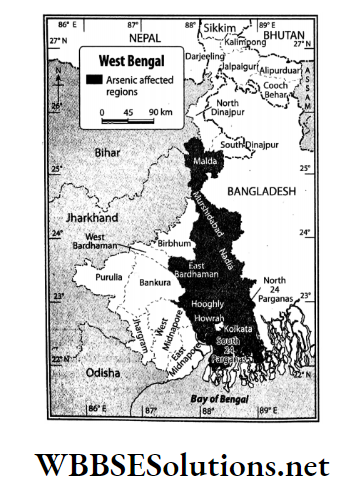
Arsenic polluted areas of West Bengal:
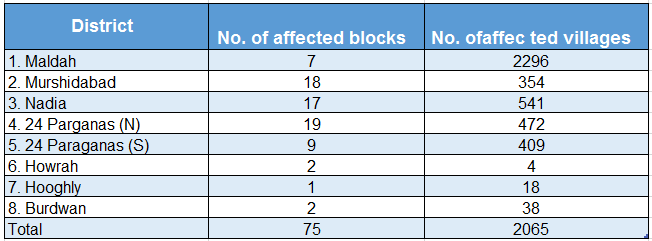
Source: Arsenic pollution in West Bengal by Dr. D. Elangovan and M.L. Chaklah.
Question 35. How does plastic pollution affect the environment?
Answer:
Plastic pollution affect the environment:
Plastic items are widely used in our daily lives. The use of plastic pollutes the environment in a number of ways-
- Plastic items thrown on roads block the drains creating hindrances to proper sewage disposal. This results in the accumulation of water which is a breeding ground for mosquitoes.
- Plastic items floating on waterbodies do not allow sunlight to enter the water bodies. As a result, aquatic plant and animal life perish, as the plants are unable to perform photosynthesis.
- Accumulation of plastic items in rivers obstructs the flow of rivers. The water becomes stagnant and as a result, the organic matter in the water gets restricted in that area and with time rots, emitting a foul odor.
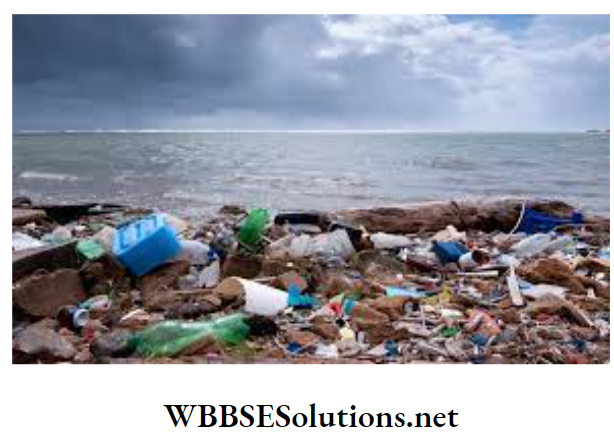
Question 36. What measures can be taken to control water crisis?
Answer:
The measures which can be taken to control the problem of water crisis are-
- Tanks should be constructed at various places to store rainwater.
- Polluted water should be treated and made suitable for reuse.
- The unnecessary use of water should be stopped.
- Sewage systems and water supply systems should be improved.
Question 37. Mention the causes of water shortage in India.
Answer:
The causes of water shortage in our country are-
- Unwise extraction of groundwater is taking place every day through shallow and deep tube-wells. As a result, the groundwater reserves are decreasing.
- Indiscriminate use of water from ponds, lakes, etc. is decreasing the water reserves of these freshwater bodies.
- Pollution in the agricultural field and industrial areas is making the freshwater bodies polluted and unsuitable for use.
- Environmental pollution has created an imbalance in the water cycle of the Earth. This is leading to a decrease in rainfall amount.
Question 38. What role does acid rain play in water pollution?
Answer:
Acid rain plays role in water pollution:
Any form of precipitation (rain, snow, sleet, hail) mixed with sulphuric, nitric, and carbonic acid released in the atmosphere forms acid rain.
Acid rain has harmful effects on human life when acid gets deposited in rivers, ponds, seas, and oceans. Acid rain makes the water acidic and as a result, aquatic fish, insects, and algae die.
In short, this causes an imbalance in the aquatic ecosystem. Thus, we can say that acid rain is one of the main reasons for water pollution.
Chapter 7 Water Pollution Short Answer Type Questions
Question 1. Which states of India are facing a water crisis?
Answer:
Though India is a country with abundant water reserves, inefficiency in the management and distribution of water supply has led to a water crisis in many states of India.
The states of India facing water crisis are-
- Rajasthan,
- Gujarat,
- Uttar Pradesh,
- Madhya Pradesh,
- Chattisgarh,
- Andhra Pradesh,
- Tamil Nadu,
- Maharashtra,
- Telangana, etc.
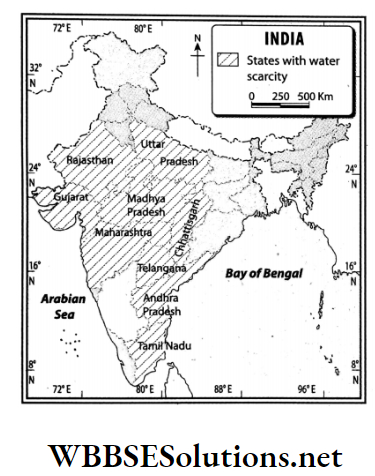
Question 2. What is water pollution?
Answer:
Water pollution:
Water pollution is the contamination of water bodies with different chemical substances which results in a change in the physical and chemical properties of water and reduces the water quality and utility.
It is very harmful to humans, animals, and water life (aquatic plants and animals). All the waterbodies of the Earth like the sea, ocean, river, lake, pond, and even the groundwater are affected by it.
Question 3. Name the chief water pollutants.
Answer:
The chief water pollutants are-

Question 4. What is the physical pollution of water?
Answer:
Physical pollution of water:
The quality of water changes when different types of polluted waste materials mix with water and it becomes unsuitable for human use. This is called physical pollution of water.
The effects of physical pollution of water are
- Change in colour of water,
- Turbidity of water change,
- Water becomes unsuitable for consumption.
On the whole, water becomes polluted.
Question 5. What is meant by water pollution of seas and oceans due to oil spills?
Answer:
Water pollution of seas and oceans due to oil spills:
- Leakage from large vessels (ships and steamers) during transportation.
- Sometimes burnt oil from ships is thrown into the oceans.
- Tanker accidents in oceans cause large scale oil-spills.
Question 6. What are the effects of oil spills?
Answer:
Effects of oil spills:
Oil spills result in the formation of a layer of oil on the surface of ocean water preventing the transfer of atmospheric oxygen into sea water. This causes breathing problems and even death of marine organisms.
The oil layer blocks the entry of sunlight into the seawater. So the aquatic plants cannot perform photosynthesis and this causes the death of plants.
Question 7. What is Itai-Itai disease?
Answer:
Itai-Itai disease:
Cadmium poisoning in humans cause severe pain in the spinal cord and joints. This is called Itai-Itai or Ouch-ouch disease. The disease first appeared around 1912 in Japan.
The mining companies in the Toyama prefecture of Japan released significant quantities of cadmium and raised the pollution levels of the Jinzu River and its tributaries.
As the water of this river, as well as that of its tributaries, was used for irrigation of rice fields, drinking, washing, fishing, etc. by the people, mass cadmium poisoning resulted.
One of the main effects of cadmium poisoning is weak and brittle bones in humans.
Question 8. What is Blackfoot disease?
Answer:
Blackfoot disease:
Blackfoot disease is caused by arsenic poisoning. Dark black patches are seen on the palms of the hand and soles of the feet. So it is called Blackfoot disease.
The symptoms are-
- Dark black patches on the soles
- Paleness of the skin
- Peeling of the skin of the hand
Question 9. What is arsenicosis?
Answer:
Arsenicosis:
Arsenicosis is a disease caused in humans as a result of excessive arsenic contamination. The symptoms of arsenicosis are-
- Black patches on the palm of hands and soles of feet.
- Black marks, spots, pimples, rashes on the body, skin irritation or even cancer may even occur.
- Lung complications like asthma, bronchitis, etc are common.
- Neurological disorders.
Question 10. What are inorganic biodegradable wastes?
Answer:
Some materials like plastic cannot be degraded by any organism or bacteria. They remain disintegrated in waterbodies for years.
As a result of this, the chemical constituents of these materials increase water pollution on one hand and on the other hand, reduce the depth of waterbodies.
Question 11. How do the drains get clogged?
Answer:
Throwing plastic bags or plastic materials in open drains hinders the smooth flow of water. Gradually water accumulates at the mouth of the drains along with waste products, excreta, etc. This is called clogging of drains.
Question 12. Do you think the fish in your aquarium will survive if phenyl or kerosene is poured into it?
Answer:
No, the fish will not survive. The application of phenyl and kerosene in the water of the aquarium will kill the fish because of their poisonous effect.
Question 13. At one time the pond near your house had sparkling clear water. People used to bathe and wash clothes in that water. But now it is filled with garbage, algae, and water hyacinth. Dead fish are seen floating in the water. Give reasons.
Answer:
Washing clothes with detergent leads to the accumulation of a phosphate-based chemical in water resulting in the growth of algae, water hyacinth, etc.
This is called eutrophication. This decreases the depth of the water. The domestic waste products thrown in the water lead to an increase in micro-organisms in the water.
Due to the increased demand of oxygen by these microorganisms, the level of oxygen in pond water decreases. Due to oxygen deficiency, fishes die and float on the water’s surface.
Chapter 7 Water Pollution Multiple Choice Questions Choose The Correct Option
Question 1. Of the total water on the Earth’s surface, about 97% is-
- River water
- Tubewell water
- Ocean water
Answer: 3. Ocean water
Question 2. Of the total water of the Earth’s surface, the percentage of fresh water is-
- 3%
- 15%
- 90%
Answer: 1. 3%
Question 3. The percentage of the Earth’s surface covered with water is-
- 43
- 71
- 13
Answer: 2. 71
Question 4. The percentage of fresh water in rivers and lakes is-
- 1
- 2
- 5
Answer: 1. 1
Question 5. _______contributes the most to water pollution.
- Thermal power plants
- Leather industry
- Paper industry
Answer: 1. Thermal power plants
Question 6. Which of the following industry is a major contributor to water pollution?
- Cotton textile
- Electronics
- Paper and leather
Answer: 3. Paper and leather
Question 7. In developed countries, water pollution is mainly caused by-
- Acid rain
- Basic rain
- Excreta of humans and domestic animals
Answer: 1. Acid rain
Question 8. In developing countries, water pollution is mainly caused by waste products of-
- Humans and animals
- Industrial by-products and wastes
- Atomic power stations
Answer: 2. Industrial by-products and wastes
Question 9. The metal which causes maximum water pollution is-
- Lead and mercury
- Iron and copper
- Sodium
Answer: 1. Lead and mercury
Question 10. What is grown to control chemical pollution in water?
- Water hyacinth
- Algae
- Lotus
Answer: 1. Water hyacinth
Question 11. Oil spills cause water pollution mainly by –
- Forming a layer of oil on the water surface
- Helping in the transfer of atmospheric oxygen to the water
- Changing the chemical nature of water
Answer: 1. Forming a layer of oil on the water surface
Question 12. Eutrophication leads to an increase in the amount of-
- Algae
- Moss in water
- Mushroom
Answer: 1. Algae
Question 13. In the waterbody, eutrophication is caused as a response to the-
- Increased nutrient levels
- Increased oxygen level
- Decreased oxygen demand
Answer: 2. Increased oxygen level
Question 14. Arsenic is a type of-
- Water Pollutant
- Air Pollutant
- Land Pollutant
Answer: 1. Water Pollutant
Question 15. Amoebiasis is a waterborne disease caused by-
- Protozoa
- Bacteria
- Virus
Answer: 1. Protozoa
Question 16. Black patches are seen on the soles of the feet of humans as an effect of-
- Mercury
- Arsenic
- Cadmium
Answer: 2. Arsenic
Question 17. A waterborne disease caused by bacteria is-
- Cholera
- Hepatitis A
- Tuberculosis
Answer: 1. Cholera
Question 18. A protozoan called Entamoeba Histolytica causes-
- Hepatitis A
- Amoebiasis
- Typhoid
Answer: 2. Amoebiasis
Question 19. Itai-Itai or Ouch Ouch disease is caused by-
- Mercury
- Arsenic Poisoning
- Cadmium
Answer: 3. Cadmium
Question 20. The effect of arsenic is observed in which district of West Bengal?
- Birbhum
- Nadia
- Jalpaiguri
Answer: 2. Nadia
Question 21. Hepatitis A is a disease that is borne by-
- Air
- Water
- Soil
Answer: 2. Water
Question 22. Fluoride is a type of-
- Useless Gas
- Useful Gas
- Harmful Salt
Answer: 3. Harmful Salt
Question 23. The enamel of teeth becomes pitted, rough, and hard to clean due to-
- Chlorosis
- Arsenicosis
- Fluorosis
Answer: 3. Fluorosis
Question 24. _______ is highly affected by arsenic contamination in water.
- United Kingdom
- India
- Iran
Answer: 2. India
Question 25. The bacteria that causes _______ looks like the punctuation mark ‘comma’.
- Typhoid
- Tuberculosis
- Cholera
Answer: 3. Cholera
Question 26. Softening of bones is caused in humans as an effect of-
- Minamata
- Itai-Itai
- Blackfoot
Answer: 2. Itai-Itai
Question 27. When we boil water, the level of arsenic content-
- Increases
- Decreases
- Remains the same
Answer: 2. Decreases
Question 28. Drinking boiled water is-
- Safe
- Harmful
- Unnecessary
Answer: 1. Safe
Question 29. Cholera is a disease borne by-
- Air
- Soil
- Water
Answer: 3. Water
Question 30. The skin disease caused due to the effect of arsenic poisoning is-
- Silicosis
- Melanosis
- Dyslexia
Answer: 2. Melanosis
Question 31. A disease caused by mercury poisoning is-
- Minamata
- Cholera
- Itai-Itai
Answer: 1. Minamata
Question 32. A waterborne disease caused by virus is-
- Polio
- Typhoid
- Amoebiasis
Answer: 1. Polio
Question 33. A waterborne disease caused by bacteria is-
- Typhoid
- Polio
- Amoebiasis
Answer: 1. Typhoid
Question 34. Excessive use of nitrate in agriculture causes-
- Jaundice
- Dysentery
- Cancer
Answer: 3. Cancer
Question 35. An increase in level of BOD indicates-
- Higher levels of water pollution
- The lower level of water pollution
- Higher levels of air pollution
Answer: 1. Higher level of water pollution
Question 36. BOD is a measure of the amount of _______ needed by microorganisms for the oxidation of organic matter.
- Carbon dioxide
- Oxygen
- Hydrogen
Answer: 2. Oxygen
Question 37. Which of the following are arsenic-tolerant plants?
- Banana and papaya
- Bean and tomato
- Paddy and wheat
Answer: 2. Bean and tomato
Question 38. The type of paddy in which arsenic level is high is-
- Aus
- Aman
- Boro
Answer: 3. Boro
Question 39. During the Gulf War which waterbody was polluted?
- Bay of Bengal
- Mexican Gulf
- Persian Gulf
Answer: 3. Persian Gulf
Question 40. Thermal pollution mainly changes the-
- Chemical properties of water
- Ecosystem composition of water
- Number of organisms in the water
Answer: 2. Ecosystem composition of water
Question 41. After the establishment of Haldia Petrochemicals, number of Hilsa fish has conspicuously decreased at the mouth of-
- Ajay river
- Teesta river
- Haldi river
Answer: 3. Haldi River
Question 42. The states of India which are highly affected by arsenic poisoning are-
- West Bengal, Bihar
- Uttar Pradesh, Haryana
- Maharashtra, Tamil Nadu
Answer: 1. West Bengal, Bihar
Question 43. The pH value of pure water is-
- 7
- 3
- 9
Answer: 1. 7
Question 44. A pesticide used to kill birds and rodents is-
- Atropine
- Strychnine
- Morphine
Answer: 2. Strychnine
Question 45. According to WHO, the number of children die every year due to waterborne diseases are-
- 30 million
- 40 million
- 50 million
Answer: 1. 30 million
Question 46. A person in the USA uses more than ________ liters of water daily.
- 50
- 70
- 80
Answer: 1. 50
Chapter 7 Water Pollution Very Short Answer Type Questions Fill In The Blanks
Question 1. ________ poisoning causes Minamata disease.
Answer: Mercury
Question 2. ________ poisoning causes Ouch Ouch or Itai-itai disease.
Answer: Cadmium
Question 3. Eutrophication is a type of ________ pollution.
Answer: Water
Question 4. Arsenic is a type of ________.
Answer: Metalloid
Question 5. The disease caused due to fluoride contamination is ________.
Answer: Fluorosis
Question 6. The ________ disease is caused due to arsenic contamination.
Answer: Blackfoot
Question 7. Due to eutrophication, organisms like ________ grow profusely.
Answer: Algae
Question 8. Due to eutrophication, nutrients like ________ increase in water.
Answer: phosphate
Question 9. Hepatitis disease is caused by ________.
Answer: virus
Question 10. Typhoid is a ________ disease.
Answer: waterborne
Question 11. Due to water pollution, the number of fishes in oceans and seas ________.
Answer: Decreases
Question 12. Pollution by ________ causes fluorosis.
Answer: Fluoride
Question 13. Increased volume of ________ in drinking water causes brown stains on teeth.
Answer: Iron
Question 14. Arsenic concentration in drinking water has been observed in ________ region of United States of America.
Answer: Nevada
Question 15. According to the Bureau of Indian Standards, the permissible level of arsenic per liter of drinking water is ________.
Answer: 0.01 milligram
Question 16. Approximately ________ of the weight of an adult human constitutes of water.
Answer: 50-60%
Question 17. The skin becomes ________ when a person is infected with jaundice.
Answer: Yellow
Question 18. Cholera is a ________-borne disease.
Answer: water
Question19. About ________ percent of the water on the Earth’s surface is saline.
Answer: 97
Question 20. Mercury pollution in Minamata Bay happened in the year ________.
Answer: 1932
Question 21. Due to the excessive use of pesticides, ________ lake in Odisha has been largely polluted.
Answer: Chilka
Question 22. Boiling the water for ________ minutes at 100°C destroys all bacteria.
Answer: 10
Question 23. In Israel, 30% of used water is reused is ________.
Answer: Irrigation
Write True Or False
Question 1. Cadmium is a water pollutant.
Answer: True
Question 2. Dysentery is a waterborne disease caused by a virus.
Answer: False
Question 3. The enamel of our teeth decays due to the contamination of arsenic.
Answer: False
Question 4. Fluoride is an element.
Answer: False
Question 5. Arsenic poisoning has been detected in some districts of West Bengal.
Answer: True
Question 6. A person infected with typhoid has a fever for a long span of time.
Answer: True
Question 7. Itai-Itai disease is caused by mercury contamination.
Answer: False
Question 8. The micro-organism that causes cholera is Vibrio cholerae.
Answer: True
Question 9. The maximum permissible level of arsenic in drinking water is 0.5 milligrams/liter.
Answer: False
Question 10. Arsenic is a metalloid.
Answer: True
Question 11. The effect of arsenic contamination has been observed in South 24 Parganas district of West Bengal.
Answer: True
Question 12. A high concentration of arsenic has been observed in the Gangetic Plain of West Bengal.
Answer: True
Question 13. Typhoid is a waterborne disease caused by bacteria.
Answer: True
Question 14. We should stop the reckless use of groundwater.
Answer: True
Question 15. Lake Baikal is a freshwater lake.
Answer: True
Question 16. ¾ parts of the Earth’s surface is covered with land and ¼ part is covered with water.
Answer: False
Question 17. SO2 and NO2 react with rainwater to form acid rain.
Answer: True
Question 18. Minamata disease was first observed in China.
Answer: False
Question 19. Chlorine can destroy bacteria in water.
Answer: True
Question 20. Sewage from the thermal plants should be directly thrown into the sea or river.
Answer: False
Question 21. You must use less alkaline soap to mitigate water pollution.
Answer: True
Chapter 7 Water Pollution Match The Columns
1.
Answer: 1. D, 2. C, 3. E, 4. A, 5. B
2.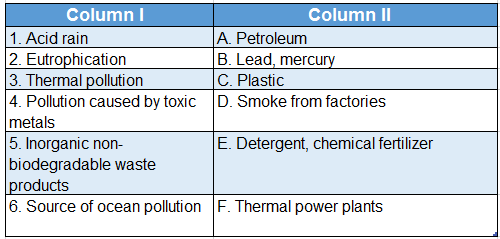
Answer: 1. D, 2. E, 3. F, 4. B, 5. C, 6. A
3.
Answer: 1. E, 2. C, 3. D, 4. F, 5. B, 6. A
Answer In One Or Two Words
Question 1. What percentage of the total water on the Earth’s surface is fresh water?
Answer: 3%.
Question 2. What is the reduction in the quality of water known as?
Answer: Water pollution.
Question 3. What are metals (including heavy metal) and metal compounds that negatively affect people’s health collectively called?
Answer: Toxic metals.
Question 4. Name one radioactive water pollutant.
Answer: Ash from the nuclear power plant.
Question 5. What is water pollution caused by hot water discharged from thermal power plants called?
Answer: Thermal pollution.
Question 6. What is the increased growth of algae and plankton in water bodies due to the effects of soaps and detergents termed as?
Answer: Eutrophication.
Question 7. Which disease causes black spots on the human body?
Answer: Melanosis.
Question 8. Which disease causes black patches on the soles of feet?
Answer: Blackfoot disease.
Question 9. Name a disease caused by mercury pollution.
Answer: Minamata.
Question 10. Name a disease caused in humans by arsenic pollution.
Answer: Arsenicosis.
Question 11. Name a disease caused in humans by fluoride poisoning.
Answer: Fluorosis.
Question 12. Name a waterborne disease caused by protozoa.
Amoebiasis.
Question 13. Name a district of West Bengal affected by arsenic poisoning.
Answer: Nadia/Malda.
Question 14. What is the permissible level of arsenic in drinking water?
Answer: 0.01 milligram/liter.
Question 15. Which chemical is used to kill microbes in water?
Answer: Bleaching powder.
Question 16. What is the hindrance of normal water flow due to the presence of plastic in drains called?
Answer: Clogging.
Question 17. Name some plants which separate sediments from water.
Answer: Pea, Pulses.
Question 18. Which term is used to denote the quantity of oxygen required by microorganisms in water from the degradation of organic matter?
Answer: Biological Oxygen Demand.
Question 19. What is the accumulation of poisonous chemical substances in organisms known as?
Answer: Bio-accumulation.
Question 20. What is the principal cause of the water crisis?
Answer: Excessive extraction of groundwater.
Question 21. What is the primary reason for the water crisis globally?
Answer: Excessive use of water.
Question 22. Name a state from our country which has an acute water crisis.
Answer: Rajasthan.
Question 23. According to the UN, how much water per day is needed for a human being?
Answer: 20 liters.
Question 24. Which country reuses used water for irrigation?
Answer: Israel.
Question 25. What are the materials like plastic which cannot be decomposed by bacteria called?
Answer: Non-biodegradable waste substances.
Chapter 7 Water Pollution Miscellaneous Type Questions Find The Odd One Out
Question 1. Malda Ganga river: Tubewell: Arsenic
Answer: Ganga river
Question 2. Blackfoot: Fluorosis: Itai-Itai: Acid rain
Answer: Acid rain
Question 3. Japan Minamata Mercury infection: Eutrophication
Answer: Eutrophication
Question 4. Cholera: Acid rain: Jaundice: Typhoid
Answer: Acid rain
Question 5. Arsenic Fluoride Cadmium: Nitrate
Answer: Nitrate
Correct The Following
Question 1. Cadmium pollution causes black ulcers on hands and feet.
Answer: Arsenic
Question 2. Cholera is a disease caused by soil pollution.
Answer: Water
Question 3. About 95 percent of water on Earth is saline.
Answer: 97
Question 4. The environment on the coast of Minamata Gulf became polluted due to arsenic pollution.
Answer: Mercury
Question 5. Almost 10 million children all over the world die due to water pollution.
Answer: 30
Question 6. A certain quantity of detergent destroys the germs in water.
Answer: Chlorine
Who Am I
Question 1. I am a process through which the amount of algae in waterbodies increases and gradually the waterbodies get depleted. Who am I?
Answer: Eutrophication
Question 2. I am a metalloid causing the Blackfoot disease. Who am I?
Answer: Arsenic
Question 3. I am a microbe causing cholera. Who am I?
Answer: Vibrio cholerae
Question 4. I am a chemical which purifies water. Who am I?
Answer: Chlorine
Question 5. I am the chemical that causes the Fluorosis disease. Who am I?
Answer: Fluoride
Question 6. I am the metal that causes ‘Itai-Itai’ disease. Who am I?
Answer: Cadmium
Question 7. I am the metal that causes Minamata disease. Who am I?
Answer: Mercury
Question 8. I am a process by which the number of organisms in the water and the oxygen demand of the water body increases. Who am I?
Answer: Eutrophication
Question 9. We are such types of power stations which cause thermal pollution of water. Who are we?
Answer: Thermal power
Question 10. If the level of my presence in drinking water becomes more than 0.01 milligram/liter, it harms human life. Who am I?
Answer: Arsenic
Scrambled Words
1. LUONWAPOTTILER
2. DISUUROXLPHDEI
3. CKDISEFOAASOTEBL
4. UOFLSROSI
5. CATRHIONEUTIOP
Answer:
1. WATER POLLUTION
2. SULPHUR DIOXIDE
3. BLACKFOOT DISEASE
4. FLUOROSIS
5. EUTROPHICATION
Chapter 7 Water Pollution Fill Up The Blanks In The Knowledge Hive
Question 1. Fill in the hive concerning groundwater pollution
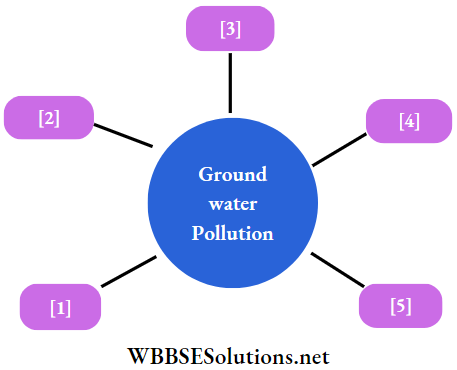
Answers:
1. The polluted water percolates through the surface of the Earth and contaminates the underground water.
2. Underground water also gets contaminated from septic tanks, dirty wells, oil wells, and garbage-clogged ponds.
3. The chemical underground pollutants are chlorides, nitrates, heavy metals, and toxic organic compounds. These compounds cause cancer.
4. The use of contaminated underground water affects the womb and causes underweight and other defects in newborn babies.
5. Nervous diseases may also occur.
Question 2. Fill in the hive concerning cadmium pollution.
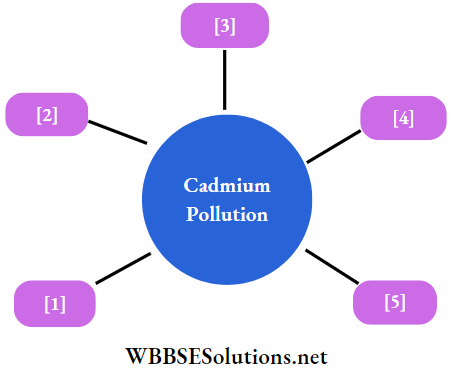
Answers:
1. The Itai-Itai disease broke out among the people living in Jintsu (Jinzu) river valley of Japan due to cadmium pollution.
2. Cadmium is used to produce coloured plastic which returns to the environment as a waste product.
3. Cadmium also mixes with the soil from chemical fertilizers during the extraction of zinc from the ore.
4. Cadmium pollution makes the bones weak and brittle.
5. Cadmium pollution causes high blood pressure.
Crossword
Question 1.

Clues
Down:
2. A water pollutant causing melanosis disease
3. Disease caused by Methyl Mercury contamination
4. Poison to kill pests
Across:
1. Phenomenon of increasing concentration of nutrients in the water
5. Disease caused by cadmium pollution
Answers:
Down:
2. ARSENIC,
3. MINAMATA,
4. PESTICIDE
Across:
1. EUTROPHICATION,
5. ITAI-ITAI
Advanced Questions And Answers
Question 1. What is hypothermia? What is the relation between hypothermia in birds and oil spills?
Answer:
Hypothermia:
Hypothermia is a condition where the core temperature of any living being fallen below that temperature which is required for normal metabolism and for carrying out functions.
Oil spills in seas and oceans cause oil slicks- a layer of petroleum on the surface of the water. This petroleum sticks to the feathers and wings of sea birds and then the birds become incapable of flying.
The feathers lose their water-proof quality. So, when the birds come in contact with water, their body temperature falls below normal and ultimately causes their death. This death of sea birds because of hypothermia usually results from oil spills.
Question 2. Which industries are responsible for polluting the rivers of India?
Answer:
Name of some industries that are responsible for polluting the rivers are given in the following table-
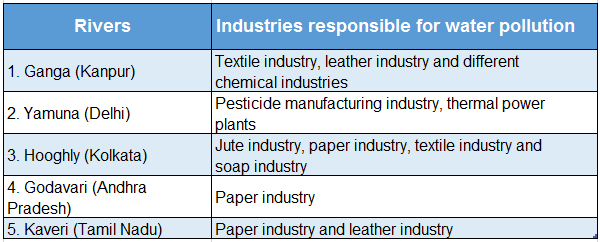
Question 3. What does BOD mean?
Answer:
BOD:
Eutrophication leads to excessive growth of algae, mosses, and other aquatic flora in the water bodies.
As they die, the quantity of oxygen required by micro-organisms like bacteria increases because of the degradation of these dead aquatic plants. This is called BOD (Biological Oxygen Demand).
It is expressed in milligrams per liter of water. We can determine the quality of water through BOD. Example-
- BOD-1-very good quality water
- BOD-3-moderately clean water
- BOD-10-polluted water
- BOD-20-very polluted water
Question 4. What is dyslexia?
Answer:
Dyslexia:
Dyslexia is a disease that may be caused by lead contamination. Lead enters the human body through food and water primarily due to soil pollution. This causes poisoning in human bodies.
The effects of dyslexia are-
- Neurological disorders
- Learning disability in children
- Respiratory problems
Question 5. What is ORS?
Answer:
ORS:
The full form of ORS is Oral Rehydration Solution. This is made by mixing water, sugar, and salt. Pharmacies sell ORS as a category of medicine containing important salts of sodium and potassium.
When severe diarrhea, dysentery or continuous vomiting occurs, large amounts of water and minerals are lost from the body. Then patients are advised to consume ORS.
Chapter 7 Water Pollution Formative
Participation
This segment will indicate how much the students have actively participated and taken initiative during the class.
Question 1. Make an investigation
- How many ponds are there in your village or locality?
- Among them how many ponds are used daily?
- What is the condition of the bank of the pond? (Constructed/Broken/Full of weeds) (iv) Are there trees and plants by the side of the ponds? What kind of trees?
- Are there any worms, insects or small animals in the water of the ponds?
- What is the condition of the water? (turbid water, reddish green or blackish water, decrease in the level of water, almost empty, full of water hyacinth and weeds, bad smell of water)
- If water is polluted, what are the reasons for it? (Bathing of cattle/draining of water of sewage and lavatory into pond water/fertilizer from cultivation land, pesticides/waste oil of factories/dye chemical, high amount of detergent, soap, garbage from the household has been mixed with water)
Answer:
Name: Purbayan Dey
School: Dumurdaha Dhrubananda High School Class: VII Sec: A Roll: 33
The subject of Survey: Survey about the pond in our area
Date: 14-02-2022
- There are seven ponds in my village
- 4
- Broken
- Yes, there are trees like mango, coconut, betel nut, bamboo, etc.
- Yes
- The water level has decreased, in some places, water has even dried up.
- Fertilizers, pesticides from farmlands.
Questioning And Experimentation
This segment will investigate the student’s understanding of the subject, questioning capacity, ability to explain and apply and urge for experimentation.
Question 1. Write about the water situation in your school or home.
- From where do you get drinking water?
- Have you ever noticed something turbid, foul odour in drinking water?
- Do you use drinking water after purifying it in anyway?
- Is anyone in your house, locality or class suffering from a stomach problem in the last three months?
- Where is the household garbage disposed of?
- Where does the sanitary water of your house drain into?
- How much soap, shampoo, and detergent is used every month?
- Are the ponds in your surroundings used for washing clothes or bathing cattle?
- If there are cultivated lands nearby, find out how much chemical fertilizers are used throughout the whole year.
- If there is any factory near your house or school, find out whether there is any provision for the purification of wastewater of the factory.
Answer:
Name: Prapti Basak
School: Jirat Colony High School Class: VII Sec: C Roll: 39
The subject of investigation: Inquiry about the conditions of water Date: 02-03-2022
- Water from tubewell and supplied under the Sajal Dhara project.
- In summer, I got filthy things in drinking water from the tubewell. But I did not see any turbidity or bad odour.
- Yes, we put the drinking water in a container after boiling and cooling. We use clean water on the top of the container after removing the dust particles from the bottom of the container.
- In the last three months, no one in my house and neighborhood has had stomach ailments, but a few of my classmates have not come to school for four days in the last week for stomach ailments.
- In our neighborhood, household wastes are collected in certain dustbins.
- The sanitary water of our house mixes with the septic tank.
- 3 to 4 soaps and laundry soaps, 150 ml shampoo, and 1 kg of detergent are used every month.
- Yes.
- The amount of chemical fertilizers used per bigha is Urea-25 kg, Potash-17 kg, Gromor-20 kg, DAP-8 kg, and Sufala-8 kg.
- There is no factory near my house, but a rice mill near my school. The waste materials emitted from it, are disposed of in a refinery adjacent to the mill.
Interpretation And Application
This segment will test whether the students have understood topics or whether they are just memorizing them.
Question 1. Now write how many people use pond water and for what purpose:
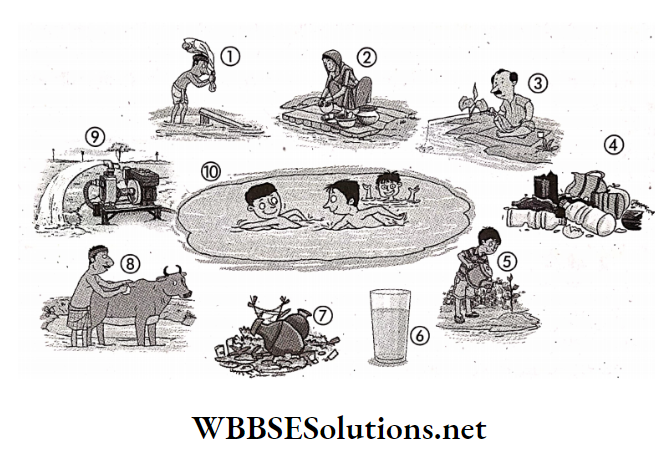
Answer: Many people are dependent on pond water for their daily activities. Uses of pond water are-
- Washing clothes,
- Washing utensils,
- Fishing,
- Disposal of garbage,
- Watering of trees,
- Use as drinking water,
- Disposal of materials,
- Bathing of cows,
- Pump irrigation,
- Bathing and swimming.
Question 2. Observe and Survey:
- If there is any lavatory within 10 meters of the tubewell and other sources of drinking water or if organic waste materials, urine, stool, garbage, or dead bodies are thrown.
- Is there any confined water around the tubewell near your home?
- Are the ropes, and buckets used in well and cleaned properly?
- Is the water of the tubewell or well turbid or filthy?
Now you can write an essay on the basis of the information collected and read it out in front of the students of your class
Answer: A model answer is provided for the convenience of the students-
Name: Debarati Dutta
School: Somra Girls High School, Class: VII, Sec.: B, Roll: 24
The subject of Survey: Source of drinking water
Date: 12-03-2022
- No, not thrown;
- No, no water logging;
- Yes, clean;
- No, water is clean and pollution free.
An essay on the basis of the information collected.
I live in Somra in the Hooghly district. We all collect drinking water from deep tubewells and wells. There are no lavatories or dumping of organic wastes within 10 meters around the tubewells and wells used for water.
The tubewells and wells have been built high around them, so there is no confined water here and there. Buckets and ropes used in wells are cleared and replaced in a timely manner.
The mouths of the wells are covered with a wooden lid at times other than the time of watering. We make sure that water is not polluted. Hence, the water of tube-wells and wells is clean and pollution tree.
Question 3. If every one of your family is provided with at least twenty liters of pure water every day, then-
- How would you use water and of what amount?
- How much water would you save and in what way?
- How much-used water would you reuse and how?
Answer: A model answer is provided for the convenience of the students-
1. Use of water:

2. Water storage:
Everybody will store water every day (20 liters – 18 liters) = 2 liters
3. Reuse of water:
Water used for bathing, washing clothes (approximately 6 liters) and for washing vegetables in cooking (approximately 2 liters) i.e. about (6+2)= 8 liters of water may be reused for watering the trees in the garden.
Aesthetics And Creativity
This segment will check the aesthetic sense and creativity of the students.
Question 1. You can submit the description of your experience to your school magazine after visiting any nearby water purification centre or water supply center.
Answer: A sample is given for the convenience of the students
Name: Ankita Saha
School: Chandernagore Banga Vidyalaya, Class: VII, Sec: C, Roll: 9
The subject of Survey: Description of water supply center travel experience.
Date: 10-02-2022
I visited Tala, the main water supply center in Kolkata, last Sunday. I am writing my experience after visiting the Tala Tank and the information I gathered –
- Construction of the tank began in August 1907 and was completed in November 1909 and was completed in November 1909 under the supervision of a British engineer. The tank is made entirely of steel.
- The tank is built on 7 bighas of land. The height from the surface to the bottom of the tank is 110 feet and the depth of the tank is 16 feet.
- The water holding capacity of the tank is 90 lakh gallons and according to the calculation of 1909, it cost Rs. 5 lakhs to build the tank. The Kolkata Municipal Corporation is responsible for its maintenance.
- The tank does not have separate pipes for water storage and supply. When water from the Palta pumping station fills the groundwater tank at the bottom of the Tala tank, excess water accumulates in the tank. After the water supply, when the amount of water in the underground tank decreases, Tala refills the underground water tank with water.
- In 2009, the 100th anniversary of this tank did not change the size of the tank, except for a few minor repairs. In the last 110 years, the tank has experienced Earthquakes and several cyclones, but no damage has been done to the tank.

